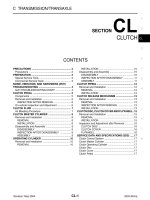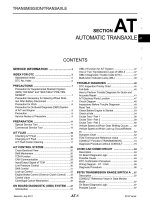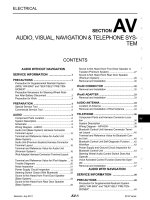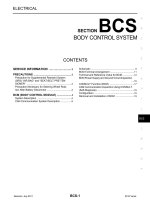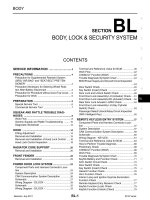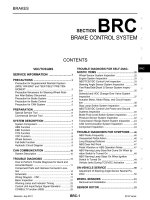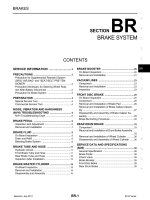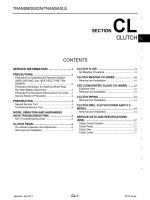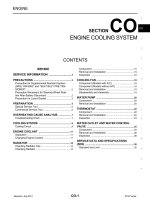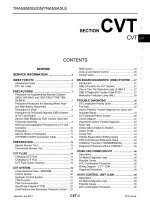CL hệ THỐNG LY hợp NISSAN VERSA HATCH BACK 2012
Bạn đang xem bản rút gọn của tài liệu. Xem và tải ngay bản đầy đủ của tài liệu tại đây (470.55 KB, 17 trang )
CL-1
TRANSMISSION/TRANSAXLE
D
E
F
G
H
I
J
K
L
M
SECTION CL
A
B
CL
N
O
P
CONTENTS
CLUTCH
SERVICE INFORMATION 2
PRECAUTIONS 2
Precaution for Supplemental Restraint System
(SRS) "AIR BAG" and "SEAT BELT PRE-TEN-
SIONER"
2
Precaution Necessary for Steering Wheel Rota-
tion After Battery Disconnect
2
Precaution for Procedure without Cowl Top Cover 3
Service Notice or Precaution 3
PREPARATION 4
Special Service Tool 4
Commercial Service Tool 4
NOISE, VIBRATION AND HARSHNESS
(NVH) TROUBLESHOOTING
5
NVH Troubleshooting Chart 5
CLUTCH PEDAL 6
On-vehicle Inspection and Adjustment 6
Removal and Installation 7
CLUTCH FLUID 9
Air Bleeding Procedure 9
CLUTCH MASTER CYLINDER 10
Removal and Installation 10
CSC (CONCENTRIC SLAVE CYLINDER) 12
Exploded View 12
Removal and Installation 12
CLUTCH PIPING 13
Removal and Installation 13
CLUTCH DISC, CLUTCH COVER AND FLY-
WHEEL
14
Removal and Installation 14
SERVICE DATA AND SPECIFICATIONS
(SDS)
17
Clutch Control System 17
Clutch Pedal 17
Clutch Disc 17
Clutch Cover 17
Revision: July 2011 2012 Versa
CL-2
< SERVICE INFORMATION >
PRECAUTIONS
SERVICE INFORMATION
PRECAUTIONS
Precaution for Supplemental Restraint System (SRS) "AIR BAG" and "SEAT BELT
PRE-TENSIONER"
INFOID:0000000007329862
The Supplemental Restraint System such as “AIR BAG” and “SEAT BELT PRE-TENSIONER”, used along
with a front seat belt, helps to reduce the risk or severity of injury to the driver and front passenger for certain
types of collision. This system includes seat belt switch inputs and dual stage front air bag modules. The SRS
system uses the seat belt switches to determine the front air bag deployment, and may only deploy one front
air bag, depending on the severity of a collision and whether the front occupants are belted or unbelted.
Information necessary to service the system safely is included in the SRS and SB section of this Service Man-
ual.
WARNING:
• To avoid rendering the SRS inoperative, which could increase the risk of personal injury or death in
the event of a collision which would result in air bag inflation, all maintenance must be performed by
an authorized NISSAN/INFINITI dealer.
• Improper maintenance, including incorrect removal and installation of the SRS can lead to personal
injury caused by unintentional activation of the system. For removal of Spiral Cable and Air Bag
Module, see the SRS section.
• Do not use electrical test equipment on any circuit related to the SRS unless instructed to in this
Service Manual. SRS wiring harnesses can be identified by yellow and/or orange harnesses or har-
ness connectors.
PRECAUTIONS WHEN USING POWER TOOLS (AIR OR ELECTRIC) AND HAMMERS
WARNING:
• When working near the Airbag Diagnosis Sensor Unit or other Airbag System sensors with the Igni-
tion ON or engine running, DO NOT use air or electric power tools or strike near the sensor(s) with a
hammer. Heavy vibration could activate the sensor(s) and deploy the air bag(s), possibly causing
serious injury.
• When using air or electric power tools or hammers, always switch the Ignition OFF, disconnect the
battery, and wait at least 3 minutes before performing any service.
Precaution Necessary for Steering Wheel Rotation After Battery Disconnect
INFOID:0000000007329863
NOTE:
• This Procedure is applied only to models with Intelligent Key system and NATS (NISSAN ANTI-THEFT SYS-
TEM).
• Remove and install all control units after disconnecting both battery cables with the ignition knob in the
″LOCK″ position.
• Always use CONSULT to perform self-diagnosis as a part of each function inspection after finishing work. If
DTC is detected, perform trouble diagnosis according to self-diagnostic results.
For models equipped with the Intelligent Key system and NATS, an electrically controlled steering lock mech-
anism is adopted on the key cylinder.
For this reason, if the battery is disconnected or if the battery is discharged, the steering wheel will lock and
steering wheel rotation will become impossible.
If steering wheel rotation is required when battery power is interrupted, follow the procedure below before
starting the repair operation.
OPERATION PROCEDURE
1. Connect both battery cables.
NOTE:
Supply power using jumper cables if battery is discharged.
2. Use the Intelligent Key or mechanical key to turn the ignition switch to the ″ACC″ position. At this time, the
steering lock will be released.
3. Disconnect both battery cables. The steering lock will remain released and the steering wheel can be
rotated.
4. Perform the necessary repair operation.
Revision: July 2011 2012 Versa
PRECAUTIONS
CL-3
< SERVICE INFORMATION >
D
E
F
G
H
I
J
K
L
M
A
B
CL
N
O
P
5. When the repair work is completed, return the ignition switch to the ″LOCK″ position before connecting
the battery cables. (At this time, the steering lock mechanism will engage.)
6. Perform a self-diagnosis check of all control units using CONSULT.
Precaution for Procedure without Cowl Top Cover INFOID:0000000007329864
When performing the procedure after removing cowl top cover, cover
the lower end of windshield with urethane, etc.
Service Notice or Precaution INFOID:0000000007329865
• Use recommended brake fluid when adding fluid to the clutch reservoir tank. Refer to MA-13.
• Do not reuse fluid drained from clutch system.
• Be careful not to splash brake fluid on painted areas.
• Use new brake fluid to clean or wash all parts of master cylinder and operating cylinder.
• Do not use mineral oils such as gasoline or kerosene. It will ruin the rubber parts of the hydraulic
system.
• If transaxle assembly is removed from the vehicle, always replace CSC (concentric slave cylinder).
Return CSC to original position to remove transaxle assembly. Dust on clutch disc sliding parts may
damage CSC seal and may cause clutch fluid leakage.
• Do not disassemble clutch master cylinder and CSC.
WARNING:
After cleaning clutch disc, clean it with a dust collector. Do not use compressed air.
PIIB3706J
Revision: July 2011 2012 Versa
CL-4
< SERVICE INFORMATION >
PREPARATION
PREPARATION
Special Service Tool INFOID:0000000007329866
The actual shapes of Kent-Moore tools may differ from those of special service tools illustrated here.
Commercial Service Tool INFOID:0000000007329867
Tool number
(Kent-Moore No.)
Tool name
Description
ST20050240
(—)
Diaphragm spring adjusting wrench
Adjusting unevenness of diaphragm spring of
clutch cover
ZZA0508D
Tool name Description
Clutch aligning bar Installing clutch cover and clutch disc
1: Assembly
2: Sleeve
3: Adapter
Power tool Loosening bolts and nuts
PCIB0017E
PBIC0190E
Revision: July 2011 2012 Versa
NOISE, VIBRATION AND HARSHNESS (NVH) TROUBLESHOOTING
CL-5
< SERVICE INFORMATION >
D
E
F
G
H
I
J
K
L
M
A
B
CL
N
O
P
NOISE, VIBRATION AND HARSHNESS (NVH) TROUBLESHOOTING
NVH Troubleshooting Chart INFOID:0000000007329868
Use the chart below to help you find the cause of the symptom. The numbers indicate the order of the inspec-
tion. If necessary, repair or replace these parts.
Reference page
CL-6
CL-9
EM-78
CL-12
CL-14
EM-100
SUSPECTED PARTS (Possible cause)
CLUTCH PEDAL (Inspection and adjustment)
CLUTCH LINE (Air in line)
ENGINE MOUNTING (Loose)
CSC (Concentric slave cylinder) (Worn, dirty or damaged)
CLUTCH DISC (Out of true)
CLUTCH DISC (Runout is excessive)
CLUTCH DISC (Lining broken)
CLUTCH DISC (Dirty or burned)
CLUTCH DISC (Oily)
CLUTCH DISC (Worn out)
CLUTCH DISC (Hardened)
CLUTCH DISC (Lack of spline grease)
DIAPHRAGM SPRING (Damaged)
DIAPHRAGM SPRING (Out of tip alignment)
PRESSURE PLATE (Distortion)
FLYWHEEL (Distortion)
Symptom
Clutch grabs/chatters 1 2 2 2 2 2
Clutch pedal spongy 1
Clutch noisy 1
Clutch slips 1 2 2 3 4 5
Clutch does not disengage 12 55555 5667
Revision: July 2011 2012 Versa
CL-6
< SERVICE INFORMATION >
CLUTCH PEDAL
CLUTCH PEDAL
On-vehicle Inspection and Adjustment INFOID:0000000007329869
1. Check to see if the master cylinder rod end moves freely. It
should not be bound by the clutch pedal.
a. If the rod end does not move freely, check that the ASCD switch
(if equipped) is not applying pressure to the clutch pedal causing
the rod end to bind. To adjust, disconnect the ASCD switch elec-
trical connector and turn the ASCD switch.
b. Connect the ASCD switch electrical connector (if equipped).
c. Verify that the master cylinder rod end moves freely. It should
not be bound by the clutch pedal.
d. If the rod end does not move freely, remove the rod end and
check for deformation or damage on the rod end. Leave the rod
end removed for step 2.
2. Check the clutch pedal stroke for free range of movement.
a. With the master cylinder rod end removed, manually move the pedal up and down to determine if it moves
freely.
b. If any sticking is noted, replace the clutch pedal assembly. Re-verify that the master cylinder rod end
moves freely.
3. Adjust clutch interlock switch (2) position so that clearance
between clutch pedal (1) and thread end of clutch interlock
switch (2), with clutch pedal fully depressed, is within specifica-
tion (C).
Clearance C : 0.74 - 1.96 mm (0.0291 - 0.0772 in)
PCIB1491E
WCIA0594E
Revision: July 2011 2012 Versa
CLUTCH PEDAL
CL-7
< SERVICE INFORMATION >
D
E
F
G
H
I
J
K
L
M
A
B
CL
N
O
P
4. Adjust ASCD clutch switch (1) (if equipped). Position so that
clearance between clutch pedal (2) and thread end of ASCD
clutch switch (1), with clutch pedal fully released, is within speci-
fication (A).
5. Check the clutch hydraulic system components (clutch master cylinder, clutch operating cylinder, clutch
withdrawal lever and clutch release bearing) for sticking or binding.
a. If any sticking or binding is noted, repair or replace the related parts as necessary.
b. If any hydraulic system repair was necessary, bleed the clutch hydraulic system. Refer to CL-9, "
Air
Bleeding Procedure".
Removal and Installation INFOID:0000000007329870
COMPONENTS
Clearance A : 0.74 - 1.96 mm (0.0291 - 0.0772 in)
WCIA0595E
WCIA0596E
Revision: July 2011 2012 Versa
CL-8
< SERVICE INFORMATION >
CLUTCH PEDAL
REMOVAL
1. Remove instrument lower finisher. Refer to IP-12, "Removal and Installation".
2. Disconnect clutch interlock switch and ASCD clutch switch harness connectors (if equipped).
3. Remove clutch switch harness clamp from clutch pedal assembly.
4. Disconnect master cylinder rod end from clutch pedal lever.
5. Remove clutch pedal assembly nuts, and then remove clutch
pedal assembly.
INSPECTION AFTER REMOVAL
Check clutch pedal for bend, damage or a cracked weld. If bend, damage or a cracked weld is found, replace
clutch pedal assembly.
INSTALLATION
Installation is in the reverse order of removal.
• After installing the clutch switches, adjust the switch positions. Refer to CL-6, "
On-vehicle Inspection and
Adjustment".
1. Clutch pedal assembly 2. Lock nut 3. Clutch interlock switch
4. ASCD clutch switch (if equipped) 5. Lock nut
PCIB1491E
Revision: July 2011 2012 Versa
CLUTCH FLUID
CL-9
< SERVICE INFORMATION >
D
E
F
G
H
I
J
K
L
M
A
B
CL
N
O
P
CLUTCH FLUID
Air Bleeding Procedure INFOID:0000000007329871
CAUTION:
Do not spill clutch fluid onto painted surfaces. If it spills, wipe up immediately and wash the affected
area with water.
NOTE:
Carefully monitor fluid level in reservoir tank during bleeding operation.
1. Fill master cylinder reservoir tank with new clutch fluid.
2. Connect a transparent vinyl tube and container to the bleeding
connector (1) on the CSC.
3. Depress and release the clutch pedal slowly and fully 15 times
at an interval of two to three seconds and release the clutch
pedal.
4. Push in the lock pin (1) of the bleeding connector (2), and main-
tain the position.
CAUTION:
Hold the lock pin in to prevent the bleeding connector from
separating when fluid pressure is applied.
5. Slide bleeding connector (1) in the direction of the arrow as
shown to the dimension (A).
2: clutch housing
6. Depress the clutch pedal soon and hold it, and then bleed air
from the piping. Wait for 5 seconds.
CAUTION:
Hold the clutch pedal down to prevent air from getting back
into the clutch system.
7. Return the clutch tube and lock pin to their original positions.
8. Release clutch pedal and wait for 5 seconds.
9. Repeat steps 3 to 8 until no bubbles are observed in the clutch fluid.
PCIB1494E
JPDIB0041ZZ
Dimension (A) : 10 mm (0.39 in)
JPDIB0042ZZ
Revision: July 2011 2012 Versa
CL-10
< SERVICE INFORMATION >
CLUTCH MASTER CYLINDER
CLUTCH MASTER CYLINDER
Removal and Installation INFOID:0000000007329872
NOTE:
When removing components such as hoses, tubes/lines, etc., cap or plug openings to prevent fluid from spill-
ing.
REMOVAL
1. Remove the battery, battery tray and brackets. Refer to SC-7, "Removal and Installation".
2. Remove the air cleaner and air duct. Refer to EM-16, "
Removal and Installation".
3. Use one of the following methods to remove hose from master cylinder.
• Drain clutch fluid from reservoir tank and remove hose.
• Remove hose from master cylinder.
CAUTION:
Do not spill clutch fluid onto painted surfaces. If it spills, wipe up immediately and wash the
affected area with water.
4. Remove master cylinder rod end from clutch pedal assembly.
5. Remove lock pin (1) from connector of master cylinder (2) and
separate clutch tube (3).
6. Rotate master cylinder clockwise by 45° and remove from the vehicle.
INSTALLATION
1. Tilt master cylinder clockwise by 45° and insert it in the mounting
hole. Rotate counterclockwise to secure it. At this time, nipple is
in the up position.
2. Install master cylinder rod end to clutch pedal.
PCIB1491E
PCIB1497E
SCIA1286E
Revision: July 2011 2012 Versa
CLUTCH MASTER CYLINDER
CL-11
< SERVICE INFORMATION >
D
E
F
G
H
I
J
K
L
M
A
B
CL
N
O
P
3. Install clutch tube (1) fully into connector of master cylinder (2).
4. Install lock pin (3) fully into connector of master cylinder (2).
5. Fill with new clutch fluid and bleed air from the system. Refer to
CL-9
.
6. After completing this procedure, inspect clutch pedal operation.
Refer to CL-6, "
On-vehicle Inspection and Adjustment".
7. Install the air cleaner and air duct. Refer to EM-16, "
Removal
and Installation".
8. Install the battery. Refer to SC-7, "
Removal and Installation".
PCIB1500E
Revision: July 2011 2012 Versa
CL-12
< SERVICE INFORMATION >
CSC (CONCENTRIC SLAVE CYLINDER)
CSC (CONCENTRIC SLAVE CYLINDER)
Exploded View INFOID:0000000007329873
CAUTION:
• Do not reuse CSC (concentric slave cylinder). CSC slides back to the original position every time
when removing transaxle assembly. Dust on the sliding parts may damage a seal of CSC and may
cause clutch fluid leakage.
• Do not disassemble CSC.
• Do not spill clutch fluid onto painted surfaces. If it spills, wipe up immediately and wash the affected
area with water.
Removal and Installation INFOID:0000000007329874
REMOVAL
1. Remove transaxle assembly. Refer to EM-78, "Removal and Installation".
2. Remove CSC bolts and the CSC from clutch housing.
INSTALLATION
1. Install CSC to clutch housing and then tighten bolts to specification. Refer to CL-12, "Exploded View".
CAUTION:
• Do not reuse CSC.
• Do not insert and operate CSC because piston and stopper of CSC components may fall off.
2. Install transaxle assembly. Refer to EM-78, "
Removal and Installation".
3. Bleed the air from the clutch hydraulic system. Refer to CL-9, "
Air Bleeding Procedure".
1. Transaxle assembly 2. CSC (Concentric Slave Cylinder)
JPDIB0040GB
PCIB1498E
Revision: July 2011 2012 Versa
CLUTCH PIPING
CL-13
< SERVICE INFORMATION >
D
E
F
G
H
I
J
K
L
M
A
B
CL
N
O
P
CLUTCH PIPING
Removal and Installation INFOID:0000000007329875
Carefully observe the following steps during clutch tube removal and installation.
CAUTION:
Do not spill clutch fluid onto painted surfaces. If it spills, wipe up immediately and wash the affected
area with water.
NOTE:
When removing components such as hoses, tubes/lines, etc., cap or plug openings to prevent fluid from spill-
ing.
REMOVAL
1. Remove the battery, battery tray and brackets. Refer to SC-7, "Removal and Installation".
2. Remove the air cleaner and air duct. Refer to EM-16, "
Removal and Installation".
3. Use one of the following methods to remove hose from clutch master cylinder.
• Drain clutch fluid from reservoir tank and remove hose.
• Remove hose from clutch master cylinder. Immediately plug hose and reservoir tank to prevent clutch
fluid from dripping.
CAUTION:
Do not spill clutch fluid onto painted surfaces. If it spills, wipe up immediately and wash the
affected area with water.
4. Remove clutch tube lock pin from clutch master cylinder.
5. Remove clutch tube lock pin at clutch housing.
6. Remove clutch tube lock pins (2) from clutch damper (3).
7. Remove clutch tube (1) from clutch damper (3).
8. Remove clutch damper (3) from bracket (4).
INSTALLATION
Installation is in the reverse order of removal.
• Make sure that all tubes are fully installed into connectors.
• Make sure that all connector lock pins are fully installed.
• After installation, bleed the air from the clutch hydraulic system. Refer to CL-9, "
Air Bleeding Procedure".
1. Clutch tube 2. Clutch tube lock pin 3. CSC
4. Clutch damper 5. Clutch master cylinder 6. Clutch pedal
PCIB1499E
WCIA0597E
Revision: July 2011 2012 Versa
CL-14
< SERVICE INFORMATION >
CLUTCH DISC, CLUTCH COVER AND FLYWHEEL
CLUTCH DISC, CLUTCH COVER AND FLYWHEEL
Removal and Installation INFOID:0000000007329876
COMPONENTS
CAUTION:
• Do not reuse CSC (concentric slave cylinder). CSC slides back to the original position every time
when removing transaxle assembly. Dust on the sliding parts may damage a seal of CSC and may
cause clutch fluid leakage. Refer to CL-12, "
Removal and Installation".
• Do not bring any grease to the clutch disc facing, pressure plate surface and flywheel surface.
• When installing, be careful that grease applied to input shaft does not adhere to clutch disc.
• Do not clean clutch disc using solvent.
REMOVAL
1. Remove transaxle assembly from the vehicle. Refer to MT-18, "Removal and Installation".
2. Loosen clutch cover bolts evenly. Then remove clutch cover and clutch disc.
INSPECTION AND ADJUSTMENT AFTER REMOVAL
Clutch Disc
• Measure clutch disc runout and spline backlash. If either measure-
ment exceeds the specification, replace clutch disc.
• Check clutch disc for burns, discoloration or oil or grease leakage. Replace if necessary.
1. Flywheel 2. Clutch disc 3. Clutch cover
4. Input shaft A. First step B. Final step
Apply lithium-based grease including molybdenum disulphide
JPDIB0049GB
Runout and backlash : Refer to CL-17, "Clutch Disc".
SCL221
Revision: July 2011 2012 Versa
CLUTCH DISC, CLUTCH COVER AND FLYWHEEL
CL-15
< SERVICE INFORMATION >
D
E
F
G
H
I
J
K
L
M
A
B
CL
N
O
P
• Determine the wear limit of clutch facing (depth to the rivet head).
If measurement exceeds specifications, replace clutch disc.
Clutch Cover
• With the check clutch cover installed on vehicle Check the dia-
phragm spring toe height. If unevenness exceeds specifications,
adjust the height using Tool (A).
• Check clutch cover thrust ring for wear or breakage. If wear or
breakage is found, replace clutch cover assembly.
NOTE:
• Worn thrust ring will generate a beating noise when tapped at the rivet using suitable tool.
• Broken thrust ring will make a clinking sound when cover is shaken up and down.
• If a trace of burn or discoloration is found on clutch cover pressure plate to clutch disc contact surface, repair
the surface with sandpaper. If surface is damaged or distorted, replace the assembly.
Flywheel Runout
• Check contact surface of flywheel for slight burns or discoloration.
Repair flywheel with emery paper.
• Check the flywheel runout. Refer to EM-100, "
Inspection After Dis-
assembly".
CAUTION:
Measure flywheel outer face (not on knock pin and clutch cover
mounting hole).
INSTALLATION
1. Clean clutch disc and input shaft splines to remove grease and dust caused by abrasion.
2. Apply recommended grease to clutch disc and input shaft splines.
CAUTION:
Be sure to apply grease to the points specified. Otherwise, noise, poor disengagement, or damage
to the clutch may result. Excessive grease may cause slip or shudder. If it adheres to CSC seal, it
will cause clutch fluid leakage. Wipe off excess grease.
Clutch facing wear : Refer to CL-17, "
Clutch Disc".
SCL229
Uneven limit of diaphragm
spring toe height
: Refer to CL-17, "Clutch
Cover".
Tool number A : ST20050240 ( — )
PCIB1502E
PBIC2646E
Revision: July 2011 2012 Versa
CL-16
< SERVICE INFORMATION >
CLUTCH DISC, CLUTCH COVER AND FLYWHEEL
3. Install clutch disc using suitable clutch aligner.
4. Install clutch cover. Pre-tighten clutch cover bolts.
5. Tighten clutch cover bolts evenly in two steps in the order
shown.
6. Install transaxle assembly. Refer to MT-18, "
Removal and Instal-
lation".
PCIB1772E
Revision: July 2011 2012 Versa
SERVICE DATA AND SPECIFICATIONS (SDS)
CL-17
< SERVICE INFORMATION >
D
E
F
G
H
I
J
K
L
M
A
B
CL
N
O
P
SERVICE DATA AND SPECIFICATIONS (SDS)
Clutch Control System INFOID:0000000007329877
Clutch Pedal INFOID:0000000007329878
Clutch Disc INFOID:0000000007329879
Clutch Cover INFOID:0000000007329880
Type of clutch control Hydraulic
Clearance between clutch pedal and ASCD switch threaded end
while clutch pedal is fully released (if equipped).
0.74 - 1.96 mm (0.0291 - 0.0772 in)
Clearance between clutch pedal and clutch interlock switch
threaded end while clutch pedal is fully depressed.
0.74 - 1.96 mm (0.0291 - 0.0772 in)
Engine type MR18DE
Model 225
Facing size (outer dia. × inner dia. × thickness) 225 mm × 160 mm × 3.2 mm (8.86 in × 6.30 in × 0.126 in)
Thickness of disc assembly with load 7.2 - 7.6 mm (0.283 - 0.299 in) with 5,394 N (550 kg, 1,213 lb)
Runout limit/diameter of the area to be measured 1.0 mm (0.039 in) / 215 mm (8.46 in) dia.
Maximum spline backlash (at outer edge of disc) 0.9 mm (0.035 in)
Wear limit of facing (depth to the rivet head) 0.3 mm (0.012 in)
Engine type MR18DE
Set-load 5,394 N (550 kg, 1,213 lb)
Diaphragm spring lever height 20 - 22 mm (0.79 - 0.87 in)
Uneven limit of diaphragm spring toe height 0.7 mm (0.028 in) or less
Revision: July 2011 2012 Versa
